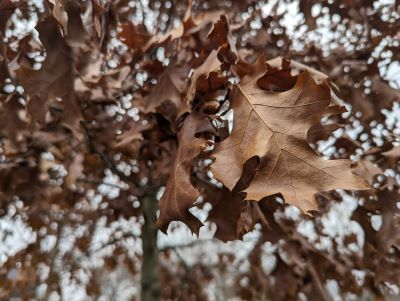
Good Natured: Marcescent Trees
Don't you just love a good word? One that lets you immerse yourself in its letters and syllables? One that challenges you a bit with its pronunciation? One that describes a phenomenon that might otherwise take many words or sentences to convey?
If so, you're not alone. I'm right there with you! There's even a word for folks like us: logophile. (For the purpose of this week's column I was really hoping that logs, and therefore trees, would figure into this term's etymology. But it actually comes from the Greek logos and philos, which respectively mean “speech, word, reason" and "dear, friendly." Oh well. Good enough.)

We're in good company too. The internet is loaded with logophiles, and one of the funniest is a blog called Questionable Skills. While not exclusively about words, and featuring more sketches than writing (which creator TedMcCagg calls “lexicographic awesomeness") the site has not once but twice featured multi-week series called The Best Word Ever.
Using the same sort of tournament brackets seen in, say, the NCAA's March Madness, Mr. McCagg pits words he's chosen from the dictionary against one another. The 2012 A bracket, for example, included the words Akimbo, Anathema and Apropos. Then, using his best judgement, along with input from his wife, he chooses a champion for each letter; those winners subsequently compete against each other for all the marbles. (Spoiler Alert: Diphthong won in 2012; in 2023, cattywampus prevailed over skedaddle, moot and wonk.)
Why do we bring all this up today, in this second week of the New Year? Because I've found what I think is The Best Nature Word Ever. Using what are no doubt questionable skills, and eliminating limited-use terms like Myrmecochory (seed dispersal by ants); Potto (my email address AND a “nocturnal, slow-moving arboreal primate" in equatorial Africa); and Frass (insect poop) I've arrived at this conclusion:
The Best Nature Word Ever is…Marcescence. It's the noun form of the word Marcescent, a Latin word that means withering without falling off. And it's happening right now, in trees throughout our area.
We've all been trained to expect leaves to fall off of trees when autumn comes. The alternate name for the season is, after all, FALL. And the definition of deciduous is “falling off or shed seasonally or at a certain stage of development."
But have you noticed that some trees don't follow the plan? Oaks, particularly younger ones, come to mind, as do ironwoods a.k.a. American hophornbeam or Ostrya virginiana, and musclewoods, a.k.a. blue beech or Carpinus caroliniana.
Here we are in January, and these trees are still sporting their foliage, which is sometimes called leafage or frondescence—another great word. Yes the leaves are brown, but they're still intact, clinging tightly even as the cold winds blow.
The physical reason behind this phenomenon is that the leaves failed to form an abscission layer between their stalks, or petioles, and the branches from which they grew.
But the bigger question, and one that doesn't seem to have a firm answer, is Why?
One theory states that the delayed leaf drop provides the trees with additional nutrients. The leaves begin to decay on the tree over winter, and then when they finally do fall in spring they can continue to break down and feed the roots.
Another take on marcescence is that it helps deter browsing herbivores. When you look at marcescent trees, you notice that they are on the smaller side; or, sometimes, they're larger but have retained the leaves on their lower branches. Either way, the boughs are well within the reach of hungry deer (and, in other regions, elk and moose). These animals, which normally seek out the tender buds on winter branches, will stroll right on by the trees with dry, crumbly leaves and seek out others whose delectable shoots are more accessible.
One undisputable benefit is that snow (if and when we do get some) will collect on marcescent trees more so than on trees devoid of leaves. Tiny pockets of air between the flakes will increase the snow's insulative properties, which then creates appealing shelter for birds contending with winter's cold. And when spring comes, that melting snow provides the tree with water.
As you look out on our winter landscape, how many marcescent trees can you spot? While you're at it how many surfaces do you see that are pearlescent? Or iridescent? Do you see any shapes that are arborescent? How many plants can you find that are suffrutescent?
Here's hoping all your days are logo-nescent!
Pam Otto is the outreach ambassador for the St. Charles Park District. She can be reached at potto@stcparks.org.

